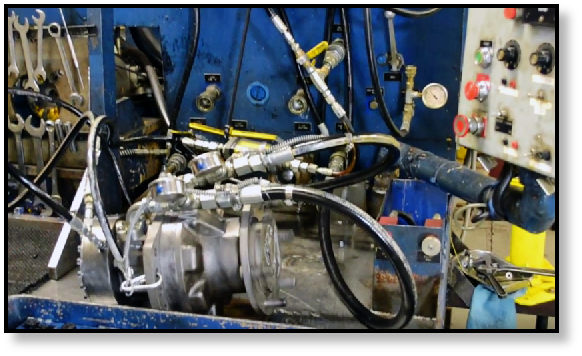Do you remember the definition of pressure? How about the difference between gage and absolute pressure? What about pressure units? It's always worth a quick review!

Here are a few other blog posts you might find helpful:
- The Ultimate Glossary of Terms About Hydraulic Motors
- 3 Things You Should Know About Gear Oil for Final Drives
- What's Wrong With My Final Drive?
Working Under Pressure
Introduction: Definition of Hydraulics
The definition of hydraulics from a scientific viewpoint is fairly straightforward: it is a branch of physics that deals with (a) the mechanical properties of liquids and (b) how they can be applied in engineering. A key part of practical hydraulics involves understanding pressure, pressure measurements, and the units used for pressure.
Pressure
The pressure that a fluid exerts is equally transmitted in all directions. In addition, that pressure always acts normal (or perpendicular) to any solid surface that it encounters. Pressure is defined as force defined by area and often represented by the formula p = F/A. This is where the British/English unit of psi came from: pound per square inch of area.
Types of Pressure Measurements
Pressure measurements are either going to be gage or absolute pressures. Gage pressure measures the pressure above atmospheric pressure while absolute pressure measures pressure above a perfect vacuum. A perfect vacuum would be a space that has absolutely no matter which means no molecules) within it.

If you see a pressure of 125.3 psia, that would be an absolute pressure reading that includes the atmospheric pressure. Any pressure reading that has an 'a' after the pressure unit is an absolute pressure. On the other hand, if there is not 'a' after the pressure unit of if there is a 'g' instead of an 'a', then the reading is a gage pressure.
Common Pressure Units
Here are some of most common units of pressure measurements you might encounter in hydraulics, starting with psi:
- psi
- psf (pounds per square feet)
- bar
- atm (1 atmosphere)
- mm Hg (mm of mercury)
- in Hg (in of mercury)
- Pa (SI/International unit_
- kPa (1000 Pa, SI/International unit)
- bar
If you need to convert between pressure units, Engineering Toolbox has a great tool for that as well as pressure conversion tables.
Atmospheric Pressure
Atmospheric pressure refers to the pressure in the air around us that results from the weight of the earth's atmosphere. Standard atmospheric pressure is 14. 696 pounds per square inch, shortened 14.7 psi, at sea level. Atmospheric pressure (also known as barometric pressure) will vary with weather conditions and does decrease with increasing altitude. In other pressure units, atmospheric pressure is ...
- 1 atm
- 101,325 Pa
- 101.325 kPa
- 760 mm Hg
- 1,013.25 mbar
Conclusion
Pressure is important when troubleshooting your final drive, and it doesn't hurt to review the basics before you check the charge pump pressure , brake engagement pressures, etc. We'll be continuing this series of hydraulic basics to review some of the basic concepts to help you better select the right components for your hydraulic equipment and make it easier for you track down the source of problems with your final drive motors and pumps.


